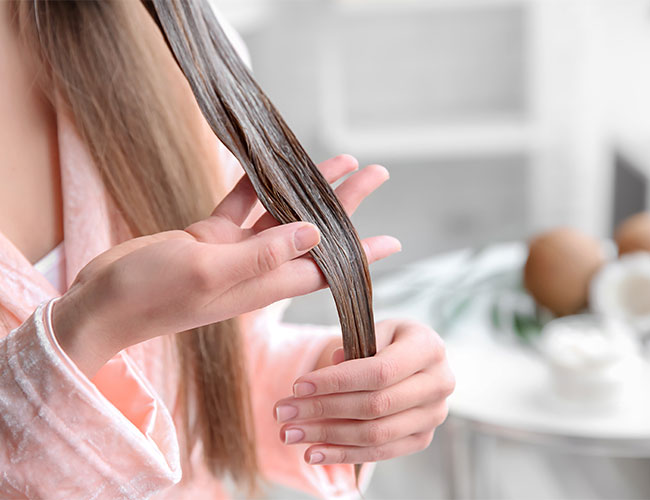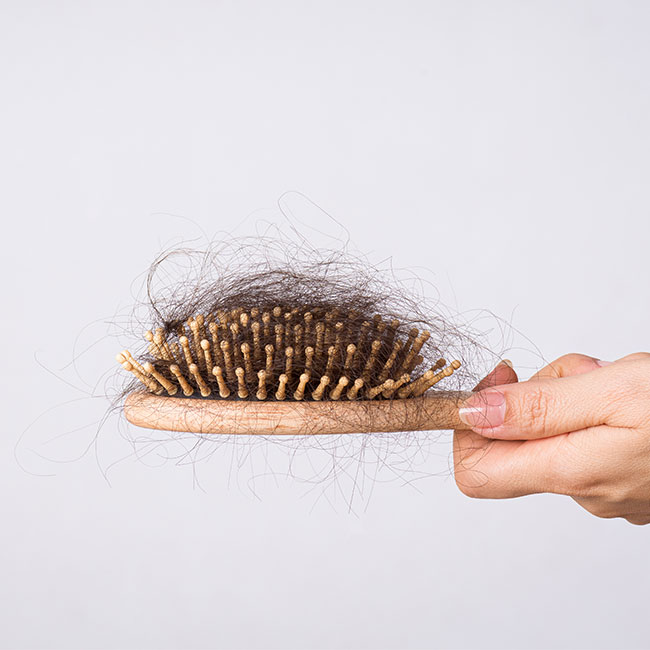
Leave-In Conditioner For Thinning Hair Due To Breakage And Damage
"Maybe you're using too much heat on your strands or your last color treatment didn't turn out as planned. Either way, you're experiencing breakage that's leaving your hair thinner and broken off after mid-length. It affects the ends more because they are older than the roots and more prone to damage," Abdullah says.
Once damaged, "the protective cuticle layer of the hair is compromised." She adds, "This can happen from everyday heat use, high heat or corrosive chemicals. When this [occurs], the hair becomes overly porous and can't hang on to moisture. Therefore, it becomes brittle and breaks off. Your hair almost certainly has split ends and might even have mid-length fissures."
Abdullah warns, "You'll need to be extra gentle to your hair to avoid having to clip off all the damage. There is no cure for hair damage, except to cut it off. But to stop it from breaking, you can use deep conditioners to replace moisture and use leave-in conditioners to coat the hair shaft."
In this scenario, she shares that "a good leave-in conditioner will help replace the areas of the hair cuticle that are missing temporarily." The product also allows your hair "to retain much-needed moisture and fill out uneven and thinning tresses."
Look For Ingredients That Aid The Hair Cuticle, Like:
Silicones
"Silicones have a bad rep, but as long as you wash them out properly, they are very good for damaged hair. Silicones like dimethicone and cyclopentasiloxane are water-resistant, so when used on wet hair they lock in moisture. [They] also coat the hair, mimicking the hair cuticle. Just don't use two coats of a leave-in with silicone without washing the first one out."
Coconut Oil
"Coconut oil is very useful in a leave-in conditioner because it seeps into the hair shaft and helps avoid over swelling on wash day. Hygral fatigue in damaged hair is a major problem because the hair cuticle is missing and the hair can over-absorb water. When this happens, the hair cuticle sticks up and more of it can easily become detached when you're combing and styling your hair."
Keratin
"Leave-in conditioners that contain keratin can also be very useful because keratin forms a strong bond with the hair, specifically in areas where the hair cuticle is missing. But if you have a sensitive scalp, you'll want to avoid keratin or use it only on your mid-lengths, to avoid the scalp. This is because almost all keratin products require a formaldehyde-releaser in the formula to help the keratin bond to your hair. Formaldehyde-releasers like urea and quaternium-15 can irritate the scalp."
Leave-In Conditioner For Thinning Hair Due To The Natural Aging Process
According to Abdullah, "With this type of hair thinning, you might find that your hair stays the same in diameter and length, but becomes more sparse. A leave-in conditioner can help here because it stays on the hair and scalp for longer, allowing hair growth ingredients to seep in."
Look For Ingredients That Help Hair To Stay In Longer, Like:
Biotin
"Biotin is a hair growth ingredient that's traditionally taken as a supplement, but has found its way into hair care products, as well."
Rosemary
"Rosemary is a hair growth ingredient that strengthens the hair and the hair follicles."
Black Seed
"Black seed oil strengthens the hair follicles so that they don't release the hair as easily."
Peppermint
"Peppermint prolongs the anagen, or hair growth, phase. This is useful if your hair is going into the rest phase too quickly, leading to hair loss."
Castor Oil
"This is a hair growth ingredient that also moisturizes the hair."
Leave-In Conditioner For Thinning Hair Due To Alopecia
Thinning hair could also be caused by an underlying health condition called alopecia. Abdullah mentions, "You might have a genetic form of alopecia, or maybe you pull your hair too tight, use hair extensions too often, or use corrosive chemicals that over the years have done damage to your scalp. With alopecia, the hair follicles start growing a lower grade of hair that's thinner and breaks more easily. This is a warning sign from your scalp that whatever you're doing to harm it, please stop! Later, hair loss sets in. With alopecia, the leave-in conditioner ingredients for hair damage and hair thinning due to age can help reverse the process."
Look For Ingredients That Strengthen Thin Hair, Such As:
Starches
"Most volumizing products contain some form of starch to put a heavier coating on the hair than a leave-in usually does on its own. These starches help keep thin hair from breaking and allow it to look thicker temporarily."
Hydrolyzed proteins
"Hydrolyzed proteins are good for strengthening the hair from within, but they need time to penetrate. This makes them a perfect ingredient for a leave-in conditioner, as it will stay on your hair until the next wash."
Shea butter
"Shea butter penetrates into the hair shaft to build strength in thin strands and add moisture and health."


